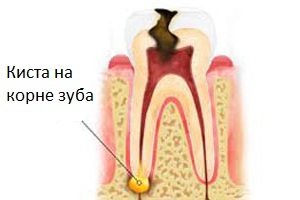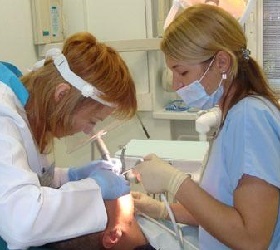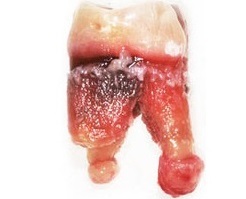 What is the tooth cyst and what is it? This inflammatory formation, which is an extremely dense capsule. It is formed to limit the spread of the developing infection. The cyst develops near the root of the tooth in the gum, sometimes near the front upper tooth.
What is the tooth cyst and what is it? This inflammatory formation, which is an extremely dense capsule. It is formed to limit the spread of the developing infection. The cyst develops near the root of the tooth in the gum, sometimes near the front upper tooth.
Symptoms of a tooth cyst can be a long time and not be, but the tooth itself is under threat. The problem is that the disease is constantly progressing, the cyst is increasing, and the normal jaw tissues are dying from the inside of the tooth. The nature of the disease is much more difficult at later stages, so do not neglect treatment.
The diameter of the formation can vary from 5 mm to several centimeters. Cysts of less than 5 mm in size are called granuloma.
Tooth cyst: what is it?
The main reason for the formation of a tooth cyst is the infection in the tooth tissue.
Most often this situation is observed in the absence of timely treatment of dental caries, as well as improper filling of dental canals, malformations, trauma or infections of the nasopharynx. More rarely a cyst occurs as a result of sinusitis or some infectious disease, in which harmful microbes are transferred to the gums with blood flow.
Depending on the cause of the disease, the following types of tooth cysts are distinguished:
- Radical(root of the tooth cyst). It develops, as a rule, with chronic periodontitis.
- Follicular. It develops from the follicle envelope surrounding the crown of the tooth. Its formation occurs when the tooth is erupted as a result of infection.
- Keratokist or primary, formed from the remnants of the tooth-forming tissue in violation of its development.
- Paradental(retromolar). It can be formed with a difficult eruption of the wisdom tooth through the gum and chronic inflammation. More common is the parodental cyst of the lower wisdom tooth.
- Cyst of eruption. It is observed in children 7-10 years old during the eruption of permanent teeth.
As a rule, the disease occurs against the backdrop of a chronic inflammatory process. It increases in size due to accumulation of cystic fluid, epithelial growth and bone resorption.
Symptoms
Cyst of the tooth for a very long time can develop either completely without symptoms, or with minimal signs - there may be periodic minor pain when biting on the causative tooth or insignificant soreness with pressure on the gum in the projection of the cyst. In this case, it is detected, as a rule, accidentally - on the review radiographs about the treatment of other teeth.
In the case of a decrease in immunity (for example, against the background of a cold) - the infection in the cyst cavity usually aggravates, which is accompanied by intense purulent formation. In this case, acute pain may occur, especially when biting on the causative tooth, swelling and swelling of the gums, cheeks, the temperature may rise and weakness appear. Basically, the symptoms of the tooth cyst begin to appear when it reaches a large size (from 3 cm).
To avoid serious consequences, do not delay treatment. It should be noted that the destruction of the root, loosening of the tooth and its loss - this is not all the consequences, which should beware, Since the presence of a cyst also poses a threat to both the gum and the rest of the healthy teeth.
Photo of a cyst of a tooth
To understand what a tooth cyst is and how to treat it, we recommend that you view the following photos:
Effects
In advanced cases, the cyst can lead to the following severe consequences:
- pathological fractures of the jaw;
- abscess;
- loss of teeth in the cyst area;
- phlegmon neck and face;
- flux or periostitis;
- osteomyelitis;
- benign tumor;
- cancer;
- sepsis.
If you have a toothache, be sure to do an x-ray. This will help to identify the cyst at an early stage. Regularly monitor the condition of the mouth: thoroughly brush your teeth, remove the remnants of food after meals, rinse the mouth with special antiseptic solutions. Visit the dentist every year, treat your teeth on time.
Treatment of a tooth cyst
 When a tooth cyst is diagnosed, treatment can be performed in several ways.
When a tooth cyst is diagnosed, treatment can be performed in several ways.
All of them are effective enough, and the choice of a specific method can be done only by the dentist - he will take into account the patient's general health, size and localization of education.
To date, dental clinics offer us such treatment options:
- Therapeutic method. The essence of the treatment is the washing of the canal with medicinal preparations followed by their cementing. These drugs have a neutralizing effect on the cyst. However, its use is justified only for the treatment of formations whose diameter does not exceed 8 mm.
- Surgerycysts implies the preservation of the patient's teeth with the removal of only the tips of the roots through the incision of the gingival tissue. During the operation, the cyst is cut out, and the removed dental tissues are restored with the help of artificial materials. After the operation, the patient is prescribed a course of antibacterial drugs.
Non-surgical method
Indication for the use of this method is the formed cyst no more than 8 mm.
- The damaged tooth is opened, under which the cyst is located and the canals expand.
- The complete disinfection of the root canal with antibacterial agents is thoroughly carried out. The focus of inflammation is blocked.
- Dead tissue cysts are etched with the help of special medical devices.
- The cavity of the cyst is filled with a special solution that promotes the disappearance of pathology and restores bone tissue.
- Sealing of the canal.
At the end of treatment after a while it is important to again check the root canals of the cured tooth in order to avoid recurrence of the disease. But the treatment of a tooth cyst without an operation is often unsuccessful and expedient only if it is detected early in the early stages of development.
Removal of a cyst of a tooth
In cases where therapeutic methods of treatment do not help, it is necessary to apply a radical method, i.e. remove the cyst simultaneously with the tooth. The onset of this disease on the wisdom tooth is an indication for its removal.
Surgical treatment removes cysts and granulomas, and resection of the tip of the tooth root. If it is impossible to preserve one root, then remove the cyst and resect the damaged root and dental fragment above it. This is a less sparing method.
Resection of the apex of the root is one of the surgical methods of treatment. The doctor of the drill cuts off (makes a resection) the tip of the root from the root itself. Root resection is required if the canals are imperfectly sealed or the pin in the root canal is installed. An operation to remove a cyst or granuloma is necessarily performed under anesthesia. Resection of the root takes up to 1 hour.
Treatment of a cyst of a tooth by the laser
How else can you treat a tooth cyst by modern methods - this is laser therapy. This method is the most sparing, it not only allows a high-quality and fast removal of a benign neoplasm, but also ensures complete disinfection of the cavity and tissues around the damaged tooth.
The procedure involves local anesthesia and insertion into the cavity of the cyst by a special thin surgical tube. Laser radiation dissolves surrounding tissues, after which they are removed with a vacuum device. It is noted that laser therapy allows the tooth to be completely preserved, the distinctive characteristic is the absence of relapses.
Cost of treatment
The cost of removing cysts depends on many factors, which include:
- complexity of the disease,
- expenses for necessary materials,
- duration of the postoperative period,
- also the pricing policy of the dental clinic.
On average, the cost of surgical cyst treatment ranges from , 00 to 1, 00 rubles. The cost of therapeutic treatment, without removing the cyst at the root of the tooth, is somewhat higher than these figures, because it requires great manipulation of the tooth and takes a long time.
How to treat cyst folk remedies
 As for the people's means, there are not so many of them. You can stop the growth of the compaction itself, but you should not expect more. Most often, the dental disease itself is treated primarily, and then the cyst degradation is already observed. The emphasis is on herbal medicine and natural antibiotics.
As for the people's means, there are not so many of them. You can stop the growth of the compaction itself, but you should not expect more. Most often, the dental disease itself is treated primarily, and then the cyst degradation is already observed. The emphasis is on herbal medicine and natural antibiotics.
At home you can use:
- Rinse with a warm saline solution - a teaspoon into a glass of water;
- Decoction herbs - calendula, sage, chamomile, eucalyptus, yarrow, hyssop, thyme. An infusion of field horsetails helps especially. On a glass of water - 2 tablespoons, bring to a boil, cool and rinse every 3-4 hours. Do not swallow!
- Infusions of herbs: the root of the killer whale (iris) in half with dry sage - 2 tablespoons per 200 g of water, soak on the fire in a closed vessel for 15 minutes and cool;
- Rinse with vodka and alcohol tinctures;
- Make a gruel of garlic and place on the gum near the inflamed area.
These methods help to relieve soreness and acute inflammation, but the cyst itself does not go away and requires professional treatment.
How to prevent the disease?
With any anxiety symptom, irritation of the gums, aching pain, which can be tolerated, it is necessary to consult a dentist. Timely diagnosis of cysts is a guarantee of prompt and effective treatment of formations without the use of surgical instruments.
The remaining recommendations are fairly standard - regular cleaning of teeth, use of high-quality toothpastes and solutions, rinses and mandatory scheduled visits to the dental clinic.

How to choose probiotics for the intestine: a list of drugs.

Effective and inexpensive cough syrups for children and adults.

Modern non-steroidal anti-inflammatory drugs.

Review of tablets from the increased pressure of the new generation.
 Antiviral drugs are inexpensive and effective.
Antiviral drugs are inexpensive and effective.



